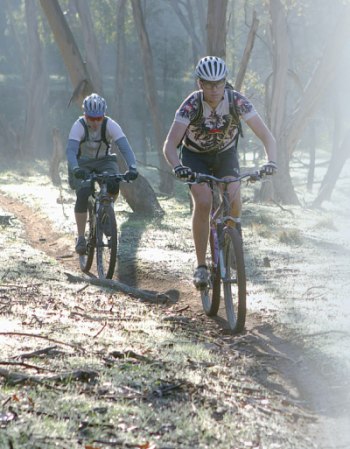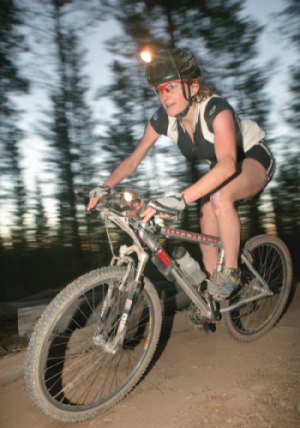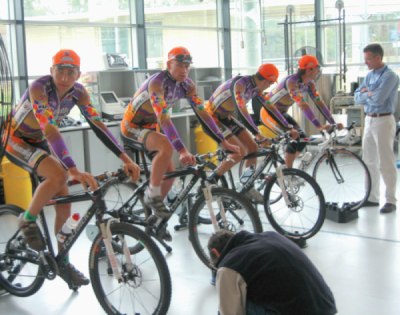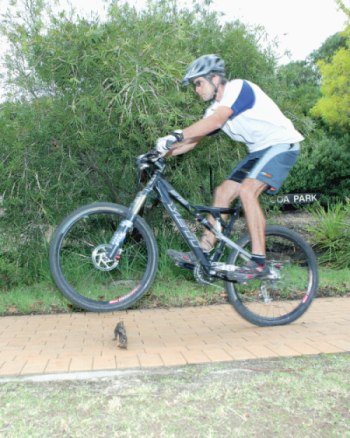Beat the Winter Blues

It is all too easy to hang the bike up when the days grow shorter and colder. An extra hour’s sleep grows more attractive than the regular Thursday morning pre-work blast along your local trails. Those Saturday afternoon group rides that no one missed all summer are cancelled due to wet and muddy conditions.
In what seems like no time, three months have passed and the bike hasn’t been outside of the garage. In turn, those jeans that fitted so well in February don’t quite button up in August. Running up four flights of stairs seems harder than it should.
When spring finally comes those first rides on the bike are not much fun at all — most of your time is spent trying to get a good breath of air. All of this is a fairly normal reaction to the seasons, but putting on weight and getting out of shape during winter is not particularly healthy and it makes it really tough to improve your riding abilities as you start from the same low base each spring.
At the end of the day, getting out and spending time on the bike is the best and most fun way to keep technique sharp, fitness up, and clothes loose. Here are some ideas that can help to keep you on the bike all winter long.
Create a Routine
Psychologically, if a person does a task regularly for around six weeks it becomes a habit. It is easiest to develop a regular riding habit in summer and then continue it into winter — being in a routine makes it easier to deal with the cold/dark/wet conditions. If starting in winter, persevere for two months and that habit will form. This applies to all aspects equally — indoor trainer sessions, morning group rides and so on. While on the way to developing that habit, it is worth establishing some other forms of motivation from the following points (like hooking up with a group or getting a coach) to assist during the hard times when giving up seems the only option.
Get a Group
Misery and fun both love company, so if you are going out in the wee hours of the morning when it is still misty and dark, possibly cold and wet, commitment to a group will help to make the getting out of bed process easier (rather than the overuse of the snooze button). I would suggest that only once a week before work is sufficient for most people — set some good habits this winter and maybe next year two days a week will seem reasonable. When starting out on a new thing, like early morning group riding in winter, not overdoing it is just as important as doing it at all.
I have seen many people drag themselves out of bed in the cold and dark of a Canberra winter morning due to the sense of responsibility to the group. Once together the riding can be extremely enjoyable, despite the cold. Groups obviously can come from anywhere: work colleagues, cycle club members or racing team-mates to name just three.
Hire a Coach
Think of it as the ‘boot camp on a bike’ approach. It is a variation on the group theme but having an official appropriate coach will also be able to assist in skills development, bike handling, posture and so on. Additionally, there is a ready source of training ideas for any member of the group who decides to get more serious with their riding.leader out there each week increases the responsibility for one to show up. If the coach shows up, then there is a bill to pay whether each rider is present or not. Having a coach to lead the ride also absolves any indecision over where the group will go, or what the group will do.

Ride at Night
Trails take on a whole different complexion in the dark. Easy singletrack can become challenging without the sun. Fire trails that are boring during the day can be quite entertaining in the dark.
It can also educate. Many riders spend too much time worrying about every little rut and rock that they ride over but none of it is visible in the dark and it doesn’t matter—in other words the small stuff can be ignored without consequences most of the time. Learn this at night and ride smoother and faster during the day.
Practice night riding all winter to justify a fancy set of lights and then be the first to volunteer for a dark lap at the next 24 hour!
Play it Smart
Take local conditions into account as the little things can have a big impact on your enjoyment. When it is cold, start the ride by ascending a hill so you warm up in a hurry. Start with a descent and you'll have a chill in your toes and fingers that can linger all day. Avoiding trails that get particularly muddy through winter; this is better for the environment and for your equipment.
Stay Inside
Do one trainer session a week. Get together with a group of mates, set yourselves up in the one room and get the music cranking — you could even play some MTB videos. It's much easier to get on the trainer and push yourself with a group of friends around doing the same thing. Triathletes are renowned for doing this all winter and it is a good plan. One high intensity session a week is enough to maintain a good level of fitness through winter when combined with some less intense outdoor riding.

If it's good enough for the AIS, it's good enough for you-group indoor trainer sessions can increase the motivation level on these otherwise unexciting training sessions.The session can be quite simple. A personal favourite is one minute hard, followed by two minutes easy repeated 20 times. While it gets boring alone in an empty room, it can be quite entertaining once the competitive spirit kicks in and you aim to push harder than everyone else in the room for each effort and try not to be the first person to fail on the way to completing the 20 repeats.
Variety from week to week is also good. After the ‘20 one minute intervals’ become stale, progress to 120 fifteen second intervals with a fifteen second recovery. It still takes one hour to complete, but it is more difficult and I do not know anyone that has made it right to the end having done an honest 120 efforts in that period. Personally, I made it to 102 last winter before I nearly fell off the bike in lactate-induced pain.
The session can also be a complicated series. My personal all-time favourite trainer workout comes straight from the research done at the Australian Institute of Sport on elite cyclists. I call it ‘the protocol’ and it is almost as difficult to describe as it is to ride.
Here is an example to illustrate: After warming up everyone gets ready for 10 seconds at 95% effort and starts on my signal, then there is 60 seconds at 75% effort. This is repeated six times. Everyone gets five minutes of easy recovery. Then back into 10 seconds at 95% effort followed by 30 seconds at 75% output. Repeat six times. Take five minutes recovery time. Finally it is 10 seconds at 95% and 10 seconds at 75% repeated six times. We take 10 minutes of recovery at this point which adds up to a total of 33 minutes regardless of the interval length chosen.
We then do a second round. The first set starts with 20 second intervals; 20 seconds at 95% followed by 120 seconds at 75%. This is only repeated three times. After five minutes recovery, the second set is 20 seconds at 95% followed by 60 seconds at 75%, repeated three times. Take five minutes to recover. And finish off the session with 20 seconds at 95% and 20 seconds at 75%, repeated three times. Cool down, have a shower and collapse.
 You don't need to hit the muddy trails to test sharpen your skills-hop a chunk of wood, practice standstills or tight turns in your garage. It is easy once you think about it.If it is crappy weather outside, there are still a bunch of fun activities that can be done without going far from home. Skills such as bunny hopping, track standing, and monos can be practiced in a garage or backyard. These won’t do much for fitness, but it all goes to keeping you on the bike all winter and developing that routine. Besides, few can claim to have perfected all of their riding skills. Place a length of two by four timber on the ground and ride along the top of it. Use a three metre long piece as a start. If there is enough room two lengths can be laid together with an angle between them, providing an even greater challenge at the turning point. With the same bit of wood, ride along one side and bunny-hop to the other side. Do this repeatedly down the length. Increase the difficulty by turning it on edge to make it stand taller. After that challenge has been mastered, progress to bigger lumber (e.g. two by eight) or even a tree trunk. Ride both along the length and across the width and learn to hop over the ever-growing obstacle. Find a gentle set of stairs, neither too steep nor too tall. Try to ride up them. On the return, try to clear the stairs with a leap and land gently at the bottom. Progress to larger stair cases. Practice standing still. Have slow races against another cyclist—last one over the finish line wins. Two riders can learn a lot about bike handling and balance having a five lap slow race inside a double garage while it is gloomy outside.
You don't need to hit the muddy trails to test sharpen your skills-hop a chunk of wood, practice standstills or tight turns in your garage. It is easy once you think about it.If it is crappy weather outside, there are still a bunch of fun activities that can be done without going far from home. Skills such as bunny hopping, track standing, and monos can be practiced in a garage or backyard. These won’t do much for fitness, but it all goes to keeping you on the bike all winter and developing that routine. Besides, few can claim to have perfected all of their riding skills. Place a length of two by four timber on the ground and ride along the top of it. Use a three metre long piece as a start. If there is enough room two lengths can be laid together with an angle between them, providing an even greater challenge at the turning point. With the same bit of wood, ride along one side and bunny-hop to the other side. Do this repeatedly down the length. Increase the difficulty by turning it on edge to make it stand taller. After that challenge has been mastered, progress to bigger lumber (e.g. two by eight) or even a tree trunk. Ride both along the length and across the width and learn to hop over the ever-growing obstacle. Find a gentle set of stairs, neither too steep nor too tall. Try to ride up them. On the return, try to clear the stairs with a leap and land gently at the bottom. Progress to larger stair cases. Practice standing still. Have slow races against another cyclist—last one over the finish line wins. Two riders can learn a lot about bike handling and balance having a five lap slow race inside a double garage while it is gloomy outside.Set a Schedule
While an elite rider’s training program will be a full and difficult week containing 15 to 30 hours of cycling activity, even a fun-only cyclist can benefit from programming their activities. Book out two hours on Saturday morning every week for a bike ride and it is much more likely to happen than if it is left to serendipity. Do not set distance goals. Wearing extra clothing in winter coupled with the colder weather makes for slower riding. Work off your ride time instead of distance and it will be much easier to stick to your goals—this is good for morale. It also works better with the idea of scheduling the ride as two hours is two hours regardless of distance covered. Prepare for rides ahead of time. If the scheduled ride is directly after work, stuffing around looking for a pair of riding socks is not doing anyone any favours when pedalling should be on the cards. Get those socks and everything else ready before work and the ride will go ahead as scheduled. For me it is critical for those early morning starts in the dark to have all my kit on the floor next to the bed in order to make my rendezvous on time.
Crosstrain
Slightly outside the spirit of staying on the bike, but it can be an excellent way to arrive as a better bike rider the following spring. Most people, particularly those with desk jobs, benefit from strength and flexibility workouts. Consider trying Yoga or Pilates and a coached strength training program during the cooler months of the year. This is vital for people who are injury prone through a muscular imbalance — in only a few months the problem can be history. Other activities to consider include trail walking. My personal choice is to walk on the same trails that I ride — it not only increases my leg stability but also gives me a new view of the trails that improves my riding ability on them. Swimming is not very synergistic with cycling, but it is an excellent recovery activity after a hard ride. Try it for a change of pace. Inline skating probably doesn’t leap to mind but it uses the same major muscle groups for propulsion as the bike and it provides a pretty intense workout. It does suffer from many of the same weather related limitations as cycling, but skating (on ice or wheels) is good fun if an indoor venue is close at hand. I didn’t recommend running because it causes a lot of niggling injuries in people who do not run all the time.
Pulling it Together
Some might be tempted to follow all of these suggestions while others may pick one idea that appears appropriate for them. Using all of the above, a winter schedule could contain from three to five rides/workouts per week:
• One short skills session
• One pre-work group ride
• An after work ride in the dark
• One weekend ride
• An indoor trainer session on the bike
• A strength activity
• A flexibility activity off the bike
Signing up for five scheduled rides per week would give you a really solid program. It may be more than some ride during summer, but for anyone who wants to improve their riding, it is impossible to substitute time on the bike — this kind of routine will provide just that. Imagine doing this and coming out of the dark and dreary winter tunnel fitter than you were last summer — now there’s some motivation!




